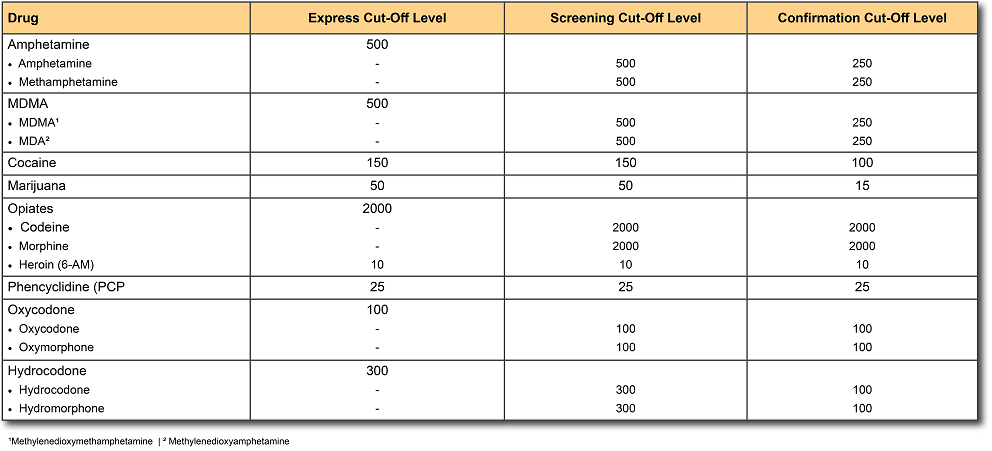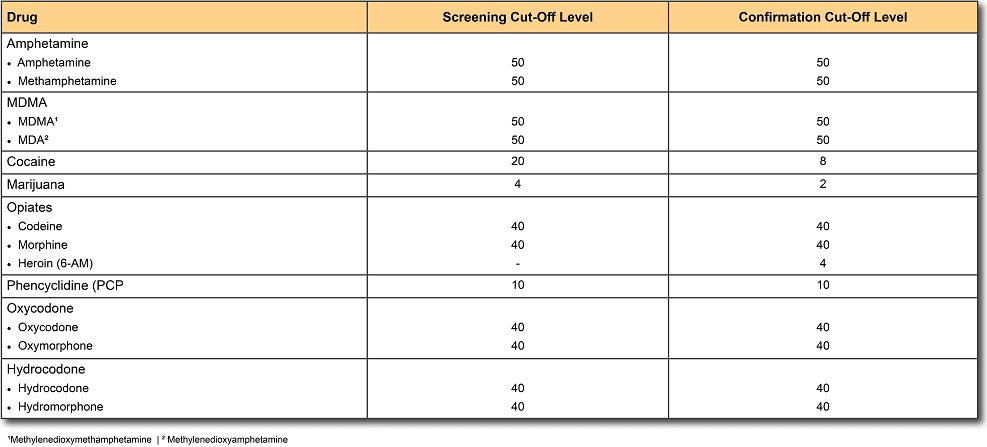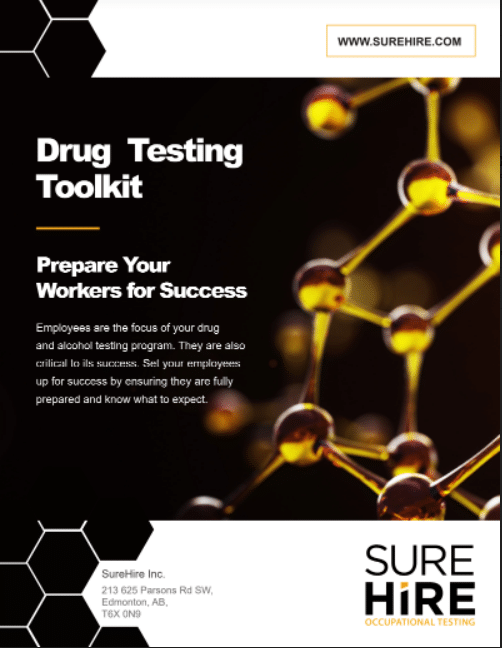TAKEAWAY: Get a primer on the 8-panel drug test, the test type that has become the default selection for many employers in their workplace drug testing programs.
Jump Ahead
Don’t have time to read the full article? Check out this short video for the information you need on 8-panel drug testing!

Keep your workplace safe and drug-free!
SureHire offers a broad range of testing options that include the 8-panel drug test as well as DOT random testing, non-DOT random testing, laboratory testing and mobile testing options. We also provide support for employer-based drug testing programs that include Reasonable Suspicion Training for supervisors and support for employees suffering from substance abuse, including access to dedicated Substance Abuse Professionals (SAPs).
Learn how SureHire can help you create a culture of safety excellence!

The pandemic has contributed to a disturbing rise in drug use, particularly fentanyl, cannabis, and methamphetamines, according to Statistics Canada. This spike in use may also be contributing to an equal increase in overdose-related injuries and fatalities across Canada. Employers concerned about the safety and well-being of their workers may be considering implementing a drug testing program to identify issues before they become serious safety risks and to help them identify employees who may need help. Learn more in 7 Reasons Your Company Should Invest in Drug Testing.
Currently, about 10% of Canadian workplaces with over 100 employees have drug testing programs in place. However, in British Columbia, where employers are struggling with increasingly high rates of substance abuse, 18% of employers have now implemented drug testing programs.
One of the most popular of these tests is the 8-panel urine drug test. Delivered as either a point of care test (POCT) or a lab test, it is the standard used in the Canadian Model for Providing a Safe Workplace (Canadian Model). However, the oral fluid test is also considered acceptable for post-incident testing, reasonable cause testing and random testing
Learn more about potential issues with oral fluid drug testing in “3 Oral Fluid Adulteration Methods You May Not Know About”. Here is everything you need to know about 8-panel drug tests.
Which Substances Does the 8-Panel Drug Test Detect?
8-panel drug tests are among the most common in Canada and the only panel drug test approved for use by the Canadian Model for post-incident, reasonable cause, and random testing. As the name implies, this panel tests for 8 drugs, including:
- Amphetamine
- Cocaine
- Methamphetamine
- Phencyclidine (PCP, angel dust, and other terms)
- Cannabis/marijuana
- MDMA (methylenedioxymethamphetamine, also known as ecstasy or molly)
- Opioids (heroin *fentanyl can be added to this panel on request)
- Oxycodone (Roxicodone and OxyContin)
Point of Care Testing vs. Lab-Based Testing
8-panel testing is either a lab-based test or a point of care test (POCT), also known as express testing.
Lab-based testing involves technicians collecting samples, which they then send to a laboratory for testing. While these tests are often considered more accurate and reliable than point of care tests, it is essential to note that the point of care test does not have higher initial cut-offs than the lab-based test.
Point of care tests can deliver results quickly, often within minutes, while it may take several days to send samples to a lab and receive results. Thus, the desired timelines for your drug testing may influence which particular testing method you’d prefer to implement for your workforce. Point of care tests also tend to be more convenient for workers and less expensive to administer for employers.
Initial testing via point of care test can be confirmed with a subsequent laboratory test to eliminate the possibility of a false positive and help ensure legal defensibility for any actions taken by the employer. Employing a Medical Review Officer (MRO) can also protect the company.
What Does “Cut-off Level” Mean?
The cut-off level is the level of concentration of a drug within a person’s system that indicates a safety risk. Companies can set acceptable cut-off levels and typically include them in their workplace drug and alcohol policy.
Most cut-off levels are based on the Canadian Model or the U.S. Department of Transportation concentration limits. Setting cut-off levels ensures both the safety and fitness for duty of employees. It also ensures that all workers are treated equally when it comes to drug testing.
There are generally 2 cut-off levels. The first is the screening concentration. If the sample exceeds this limit, the lab or tester submits it for a confirmation test. Cut-off levels for this confirmation test are generally slightly lower. There are different cut-off levels for urine testing and oral fluid testing. Here is a quick overview of the screening and confirmation levels employed in the Canadian Model.
8-Panel Urine Drug Cut-off Limits

8-Panel Oral Fluid Drug Screen Cut-Off Levels

What are Windows of Detection?
The approximate window of detection for commonly abused drugs depends on the type of test and drugs tested for. It can also be affected by usage. For example, in casual marijuana use (once per week), the THC metabolite is detectable for approximately 3 to 4 days. However, with chronic use (every day), tests can detect THC for several weeks. Learn more in 6 Factors That Influence How Long Cannabis Stays In Your System.
The liver metabolizes drugs into more water-soluble forms that can be excreted in urine by the kidneys. Many drugs, including opioids, are entirely excreted in the urine within 2 to 3 days. Others, such as PCP, stay in the bloodstream longer and are converted to metabolites that are then slowly excreted. They can be detected for up to a week in urine. Still, others, such as specific barbiturates and benzodiazepines, can be detected for several weeks.
Oral fluid testing offers a much shorter window of detection; typically 12 to 24 hours, but is an excellent method for detecting current impairment.
How Are Results Interpreted?
Companies following DOT standards will have their results sent to a Medical Review Officer (MRO). The MRO will then interpret the results, report on them, and recommend next steps. There is no such requirement in Canada; however, companies following the Canadian Model will usually employ an MRO to receive and interpret drug testing reports in confidence. The MRO will then discuss the test results with the employee and seek reasons for positive, adulterated, substituted, or invalid results.
Once the MRO makes a determination, they will report the results to the employer or employer designate as
- Negative
- Negative with safety advisory
- Refusal to test and why
- Cancelled with or without further direction
- Positive
Negative with safety advisory means that although the worker has legitimate reasons for testing positive for a drug, such as a particular prescription, they may still pose a safety risk to themselves, fellow workers or the public.

You May Also Be Interested In…
- Do You Have Reasonable Suspicion?
 Employers cannot initiate reasonable suspicion testing without first going through the 5-step process. Reasonable suspicion training provides critical information about how to initiate reasonable suspicion testing, including the 5-step process and other tools that employers can use to help manage the misuse of alcohol and drugs in the workplace.
Employers cannot initiate reasonable suspicion testing without first going through the 5-step process. Reasonable suspicion training provides critical information about how to initiate reasonable suspicion testing, including the 5-step process and other tools that employers can use to help manage the misuse of alcohol and drugs in the workplace. - An Employer’s Guide: What You and Your Employees Need to Know About DOT Drug & Alcohol Testing
 When implementing or maintaining DOT Drug & Alcohol testing, there are key areas that employers should consider.
When implementing or maintaining DOT Drug & Alcohol testing, there are key areas that employers should consider. - 2023: A Year of Changes (And It’s Not Over!)
 Kentucky, Delaware, Minnesota, Washington, and the federal Department of Transportation (DOT) have all announced changes that are either already effective or will be soon, many pertaining to cannabis.
Kentucky, Delaware, Minnesota, Washington, and the federal Department of Transportation (DOT) have all announced changes that are either already effective or will be soon, many pertaining to cannabis.

